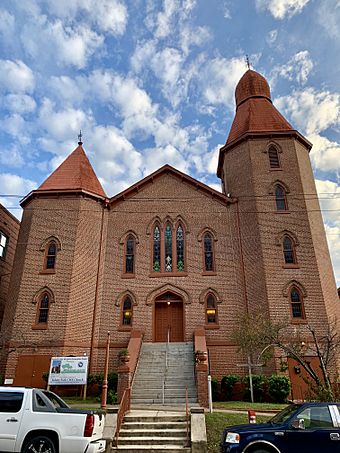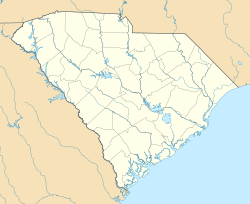Sidney Park Colored Methodist Episcopal Church facts for kids
Quick facts for kids |
|
|
Sidney Park Colored Methodist Episcopal Church
|
|
 |
|
| Location | 1114 Blanding St. Columbia, South Carolina |
|---|---|
| Area | less than one acre |
| Built | 1893 |
| Architectural style | Late Gothic Revival |
| NRHP reference No. | 96001222 |
| Added to NRHP | October 24, 1996 |
The Sidney Park Colored Methodist Episcopal Church is a very old and important church in Columbia, South Carolina. It is also known as the Sidney Park Christian Methodist Episcopal Church. This church was built a long time ago in 1893. It is made of brick and has a special style called Late Gothic Revival. This style looks grand and has tall, pointed features.
The church is special because it has the only set of eight-sided towers in Columbia. Each tower has a tall, pointed roof called a steeple. The church also has tall, narrow windows and pointed arches. Strong supports on the outside walls help hold it up. Inside, there is a strong wooden roof structure. The people who worshiped here, an African-American group, were very involved in the civil rights movement. They worked for equal rights for all people. They also had strong ties to the NAACP. The church was added to the National Register of Historic Places in 1996. This means it is a very important historical building.
Contents
A Look at the Church's Design
The Sidney Park Church shows off a beautiful architectural style. It is known as Late Gothic Revival. This style was popular in the late 1800s. It brings back ideas from very old European churches.
Unique Towers and Windows
One of the most striking parts of the church is its towers. They are not round or square, but eight-sided. These octagonal towers are unique in Columbia. Each tower is topped with a tall, pointed steeple. The church also has special windows called lancet windows. These are tall and narrow, with pointed tops. You can also see pointed arches over the doors and windows.
Strong Structure and Supports
The building has strong wall buttresses. These are supports built into the outside walls. They help to hold up the heavy brick structure. Inside, the church has a heavy timber truss system. This is a strong framework of wooden beams. It supports the roof and helps the building stand tall.
The Church's Role in History
The Sidney Park Church is more than just a building. It has played a big part in the history of Columbia. Especially, it was important for the African-American community.
Working for Equal Rights
The people of this church were very active in the civil rights movement. This was a time when many people worked to make sure everyone had equal rights. The church was a place where people could meet and plan. They worked together to bring about important changes.
Connection to the NAACP
The church had a strong connection with the NAACP. This group is very important in the fight for civil rights. The NAACP works to end unfair treatment based on race. The Sidney Park Church helped support these efforts. It was a place where people could come together for a common cause.
Images for kids




